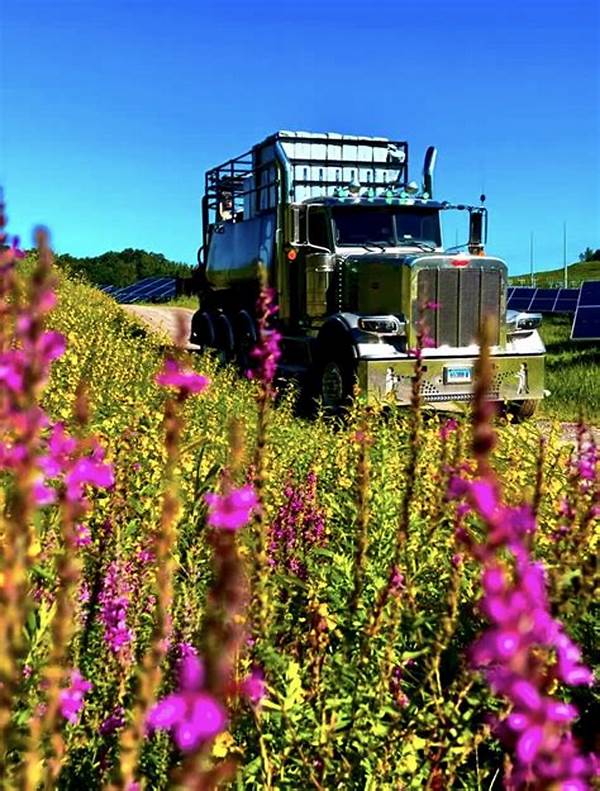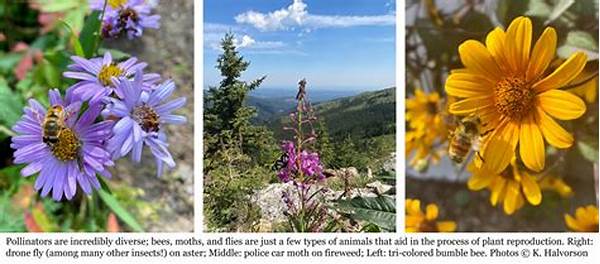Harnessing the synergy of nature in agriculture is a step towards sustainable farming and ecological balance. Integrating wildflowers into farmlands is not just a trend; it’s a transformative approach that enhances biodiversity, boosts crop yields, and supports pollinators while enriching the farmer’s experience with the land. This not-so-secret weapon in sustainable agriculture is rapidly gaining recognition for its multifaceted benefits.
Read Now : Integrating Fish And Plant Growth
The Benefits of Wildflowers for Crop Yield
Imagine a landscape where vibrant wildflowers attract a myriad of beneficial insects, creating a harmonious environment that increases crop productivity. By integrating wildflowers into farmlands, farmers can see substantial improvements in yields. These blooms provide essential habitats for pollinators such as bees and butterflies, which are crucial for the pollination of many crops. Furthermore, wildflowers help in reducing pests naturally by attracting predatory insects that feed on crop-destroying pests. With pollinators in abundance and a natural pest control army on the job, crops can achieve their true potential, resulting in better quality and quantity. Farmers, therefore, have an opportunity to embrace an approach that is cost-effective and environmentally friendly while increasing their harvests.
Having wildflowers flourish alongside crops serves as a powerful reminder of nature’s intrinsic capability to balance itself. It reduces the need for chemical fertilizers and pesticides, thus lowering production costs and promoting a healthier, more sustainable ecosystem. As stewards of the land, farmers adopting this practice aren’t just growing crops—they are cultivating a future where agriculture coexists with nature’s beauty and bounty.
Ecological Advantages of Integrating Wildflowers
1. Enhancing Biodiversity: By integrating wildflowers into farmlands, we nurture diverse ecosystems, encouraging the proliferation of various beneficial species.
2. Soil Health Improvement: Wildflowers aid in maintaining soil integrity, promoting microbial activity, and preventing erosion.
3. Natural Pest Control: The presence of wildflowers attracts beneficial insects that naturally prey on pests, reducing the need for chemical treatments.
4. Water Conservation: Wildflowers improve soil structure, enhancing water retention and reducing the need for frequent irrigation.
5. Climate Resilience: As climate change impacts agriculture, wildflowers offer resilience by supporting pollinator populations and reducing soil erosion.
Economic Impact of Wildflower Integration
Integrating wildflowers into farmlands is not just an environmental endeavor, but an economic boon. By fostering a natural ecosystem that supports crop health, farmers can significantly reduce costs associated with synthetic inputs. With wildflowers acting as natural pest deterrents, the reliance on chemical pesticides decreases, bringing down expenditures and minimizing environmental harm. Moreover, healthier crops often translate into better market prices, enhancing farm profitability.
This strategy is also an investment in long-term soil health. Healthy soils contribute to sustained productivity, ensuring that farmlands remain fertile and productive over the years. By reducing soil erosion and enhancing nutrient cycling, wildflowers help preserve the land’s vitality, ensuring continued economic benefits. The integration of wildflowers into farmlands becomes a win-win situation, aligning economic incentives with ecological integrity.
Challenges and Considerations
While the advantages are compelling, effectively integrating wildflowers into farmlands requires thoughtful planning and management. One challenge is educating farmers about the specific types of wildflowers that will best suit their crops and climate conditions. It’s important to select species that are not only non-invasive but also beneficial companions to the crops being grown. Farmers must also consider the timing of planting wildflowers to synchronize with the agricultural calendar, ensuring that their blooming periods align with critical pollination windows.
Furthermore, wildflower integration needs to be tailored to the unique characteristics of each farm. Soil type, weather patterns, and existing biodiversity all play a role in determining the most effective approach. Collaboration with ecologists and agricultural specialists can help devise a strategy that maximizes benefits while minimizing potential disruptions to existing farming practices.
Implementing a Wildflower Strategy
1. Assess Farm Conditions: Evaluate soil types, existing biodiversity, and weather patterns to tailor wildflower integration effectively.
2. Choose the Right Species: Select non-invasive wildflower species that complement specific crops and local climate conditions.
3. Plan Planting Timelines: Synchronize wildflower bloom periods with critical crop pollination windows for maximum benefits.
Read Now : Crop Resilience In Organic Farming Systems
4. Collaborate with Specialists: Work with ecologists and agricultural experts to design a comprehensive integration plan.
5. Monitor and Adapt: Continuously assess the integration’s impact and adjust strategies to optimize benefits.
6. Educate and Train: Provide training for farm workers on the benefits and management of wildflower areas.
7. Incorporate Mixed Crops: Consider mixed cropping systems that benefit from wildflower diversity in pest control and pollination.
8. Align with Sustainability Goals: Ensure wildflower integration aligns with broader farm sustainability objectives.
9. Promote Local Wildlife: Design wildflower patches to provide habitats for local wildlife, enhancing farm ecological diversity.
10. Seek Financial Incentives: Explore government and non-profit programs offering financial support for sustainable practices like wildflower integration.
Social and Cultural Dimensions
The social and cultural dimensions of integrating wildflowers into farmlands cannot be underestimated. This approach celebrates not only the natural beauty of the countryside but also fosters a deeper connection between people and the land. By incorporating wildflowers, farms become more than production zones—they transform into spaces where biodiversity thrives and communities connect with nature.
Many communities view wildflowers as a revival of traditional farming practices that respected and coexisted with the natural environment. This renewed appreciation contributes to a cultural shift toward sustainable agriculture, encouraging more people to support and engage with farms practicing eco-friendly methods. In essence, integrating wildflowers into farmlands bridges the gap between modern farming and the timeless beauty of nature, instilling a sense of environmental stewardship in both farmers and the wider community.
Future Prospects and Innovations
As innovative practices continue to emerge, the future of integrating wildflowers into farmlands is promising. Advanced research in plant biology and ecology will likely yield new insights into optimizing biodiversity on farms. The development of technology, such as drones for monitoring pollinator activity and plant health, further enhances the effectiveness of wildflower integration. These advancements hold the potential to make this approach more accessible and efficient for farmers worldwide.
Moreover, as consumers become more aware of sustainable practices, the demand for products grown in environmentally friendly conditions is expected to rise. This trend provides an economic incentive for more farmers to adopt wildflower integration, thus expanding its impact. As a forward-thinking approach, integrating wildflowers into farmlands embodies a vision of agriculture that harmonizes with nature, ensuring a sustainable future for generations to come.
Integrating Wildflowers: A Call to Action
Farms are not just points on a map—they are living ecosystems with the power to lead the charge in environmental responsibility. By integrating wildflowers into farmlands, we shift the narrative towards an agricultural future where sustainability and profitability go hand in hand. Join the movement today by embracing wildflower integration, and take a definitive step toward revolutionizing both farming practices and ecological stewardship for the betterment of our planet.



